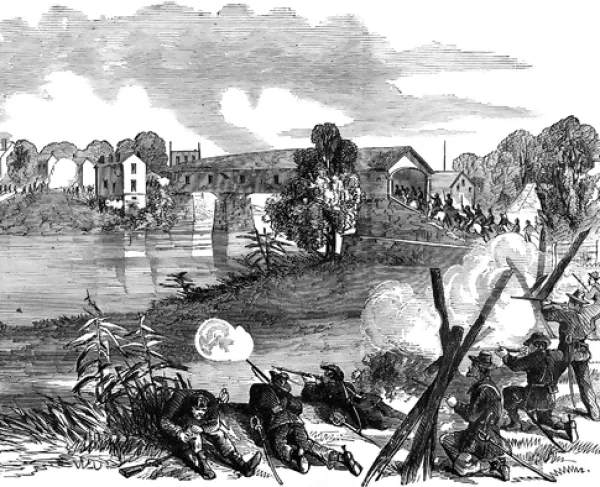Knoxville: A Near-Death Experience
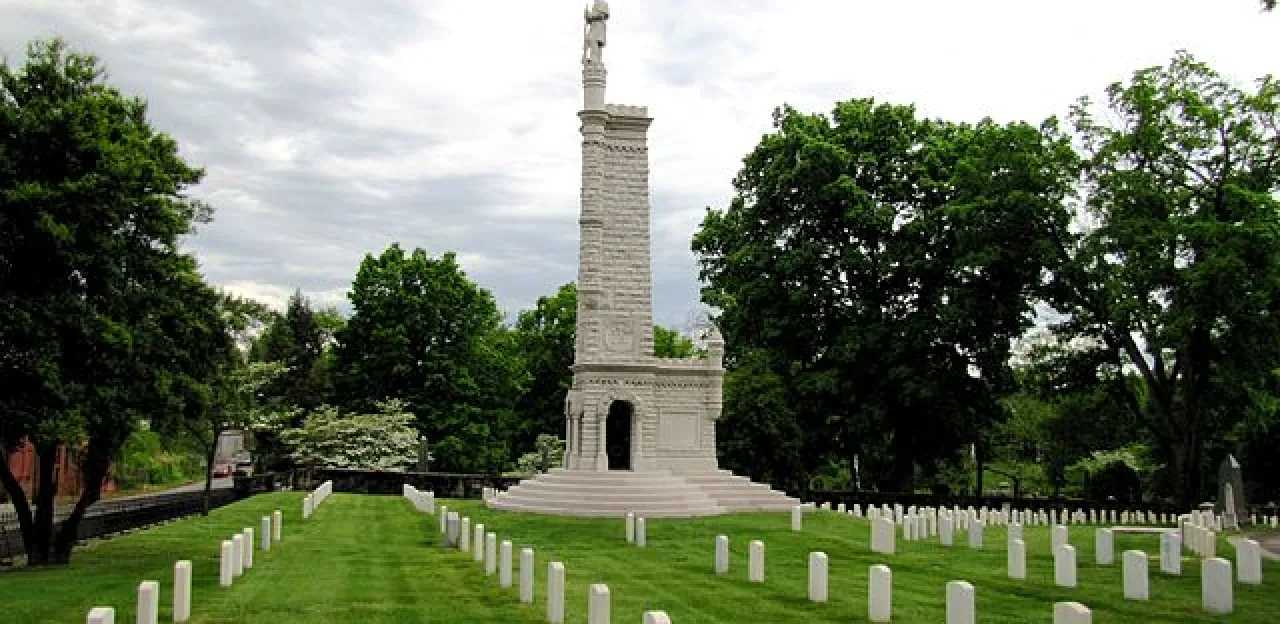
Joan L. Markel, PHD; Hallowed Ground Magazine, Fall 2013
In the fall of 1863 the nation’s attention was focused on the Western Theater. The dual Union victories at Gettysburg and Vicksburg that summer had left the Federals poised to advance deep into a Confederate heartland already “halved by Grant and being quartered by Burnside and Rosecrans,” according to Boston’s Liberator. But then the unanticipated Battle of Chickamauga in northern Georgia shocked the prevailing prognosticators. Confederate Gen. Braxton Bragg, fresh from that impressive victory, held the high ground, and the starving Union army was under siege at Chattanooga.
Once the defeated Federals retreated into Chattanooga, their plight took top military priority. Suddenly, reinforcements arrived in droves, and four major armies, commanded by some of the Civil War’s most noted officers — Maj. Gens. Joseph Hooker, Ulysses S. Grant and William T. Sherman for the Union, and Lt. Gens. James Longstreet and John Bell Hood for the Confederacy — were converging on the region. The victory at Chickamauga reinvigorated the Confederate military outlook for a few optimistic weeks before all resultant advantage was wasted. How could Bragg fail to follow up on so spectacular a victory? How could Jefferson Davis suggest a reduction in the Confederates’ strength at that critical juncture? Why were Longstreet and more than 17,000 troops sent to Knoxville?

There were serious deficiencies in capability and judgment at the highest levels of Confederate command in October 1863. Alerted to a unanimous vote of nonconfidence against Bragg by his subordinate generals, Confederate president Jefferson Davis arrived to settle the personnel dilemma. As part of the resolution — perhaps inspired by a letter from Gen. Robert E. Lee that wished omniscience had allowed them to send Longstreet against Knoxville and Maj. Gen. Ambrose Burnside, rather than into north Georgia — Davis dispatched Lee’s “old war horse” on an ill-considered foray into east Tennessee. As an elated Grant later wrote in his autobiography, “On several occasions during the war [Davis] came to the relief of the Union army by means of his superior military genius.”
Coping with serious tension among his staff, only a vague promise of supplies and his own prediction of failure, Longstreet reluctantly accepted his orders. On November 4, 1863, he departed for Knoxville, where an uninterrupted series of misjudgments and calamities would dog his progress. Accurate maps were unavailable (“Major-General Buckner was kind enough to give me some inaccurate maps of the country along the Holston—all that he had,” wrote Longstreet) and usable intelligence scarce. It took 11 days to transport his 12,000 infantry, artillery and an essential pontoon bridge 70 miles up the east Tennessee and Georgia Railroad, due to the precautionary destruction of the vital bridge at Loudon by Confederate forces weeks earlier. Longstreet detached 5,000 cavalry under Maj. Gen. Joseph Wheeler to attack Knoxville from the south — ostensibly a good move, except it prevented them from playing a potentially decisive role in the imminent artillery duel at Campbell’s Station.
In sharp contrast, east Tennessee offered Ambrose Burnside a semblance of redemption after the disastrous December 1862 Battle of Fredericksburg. In Knoxville he was respected and loved by both his troops and local citizens, although hampered by insufficient resources to meet his military goal of retaining control of the railroad supporting Rosecrans. When Grant took over command in Chattanooga, the pair quickly agreed that Burnside would keep Longstreet away from Chattanooga for as long as possible, an ever-confident Grant effectively telling Burnside, “When I whip them here I will come to your rescue.”
Burnside personally travelled on the vital train line to Loudon, where his arrival immediately invigorated the wet, despondent troops who thought they were in winter camp. Following the plan, Burnside set out to lure Longstreet back toward Knoxville, where preparations were already being made to adopt a long-term defensive position. Union performance on November 16, at the Battle of Campbell’s Station, 16 miles west of Knoxville, played out “like moves on a chess board”, according to one observer. The victorious Federals held the road in present-day Farragut, promising a safe return to Knoxville as the Confederate troops pursued.
On paper, Burnside’s position was precarious. Although some telegraph communication to the east was available via the Cumberland Gap, he could not easily confer with Grant and was effectively cut off from supplies and easy reinforcement. And, both men were under siege. Despite this, Burnside was confident; unlike so many times earlier in the war, at Knoxville, this time he had control of the situation.
Knoxville and the Triumph of Orlando Poe
Orlando Metcalfe Poe was born in Ohio in 1832. An 1856 graduate of West Point, he began the Civil War as a promising young engineer on the staff of Gen. George McClelland. However, neither engineering accomplishments nor combat experience could save his appointment to the rank of brigadier general of volunteers when Congress voted against endorsing his commission. Poe reverted to the rank of captain, and was ordered west to serve with Burnside in 1863.
During the arduous late-August campaign over the mountains from Kentucky, Poe immediately began to gather all the information possible about the newly occupied territory. He took cogent notes and made careful measurements. Terrain, mileage, the locations and conditions of roads, trails, landmarks, waterways, fords, bridges, houses and the loyalty of the people within, mills, tanneries, churches — any item of demographic detail was potentially of value to an occupying army. The compilation of this intelligence led to the creation of indispensable maps. His map of Knox County, dated November 14, 1863, provided his commanding general with unequaled decision-making information.
But engineers also saw combat, and Poe was an active cavalry participant in the October 10 Battle of Blue Springs. With his West Point classmate and close friend Col. William P. Sanders, Poe suggested aggressive new tactics for cavalry success. The pair were affectionately called “hotheads” by Burnside, who repeatedly expressed great confidence in the abilities of the dashing young officers. In late October, Poe used railroad cars to move the heavy pontoon bridge from Loudon for installation at the end of First Creek and placed forts and artillery on the knobs south of the river. When ordered by Burnside to prepare for battle, Poe began to implement his already formulated plans to carry out the grand Federal strategy.
To such a skilled engineer, this was the perfect opportunity to demonstrate the value of a top-rate military education. The land astride the Holston (now Tennessee) River on which Knoxville had been settled was a natural fortress. Simply put, resources were more than adequate. Hills were distributed at intervals around town awaiting the placement of artillery; the river and abundant creeks meant lowlands could be flooded in strategic locations — infantry simply can’t march through five feet of standing water; plentiful heavy red clay was available for fort walls; and although depleted by two years of Confederate army occupation, wood was still available.
In anticipation of fortification needs, Poe had requisitioned all the picks and shovels he could carry over the mountains. When the Confederate army had hurriedly marched out of Knoxville in late August, they left behind an irregular assortment of materials, but Poe soon proved adept at thinking beyond the textbook. The telegraph wire stored at the railroad depot proved particularly useful for lashing captured pikes together to be used like abbatis. Artillery shells were machined to fit Union cannon, and the water powered mills on the creeks were seized. Cotton bales were covered with green hides to prevent them from being set on fire by artillery sparks before they were used to increase the height of the parapets.
Poe also had ample manpower for his construction crews. Regular troops were augmented with new local recruits, civilians (both enthusiastic and begrudging) and “contraband” labor. In his official report Poe stated, “And here I feel it is my duty to refer to the great value of the services of the contrabands. They were ever tractable and willing, and many of them came to me and volunteered to work. They did an amount of labor which was truly astonishing. Day and night they worked without murmur. For the first week they labored regularly eighteen hours out of the twenty four, and during the whole siege, out of nearly 200 that we had at work, only 1 asked to be relieved, and he for only one afternoon.”
The Union also worked closely with east Tennessee residents, who delivered valuable intelligence, including the threat of a raft to be sent down the river to take out the pontoon bridge. Poe had to design and install a boom cable across the river to protect the indispensable crossing.
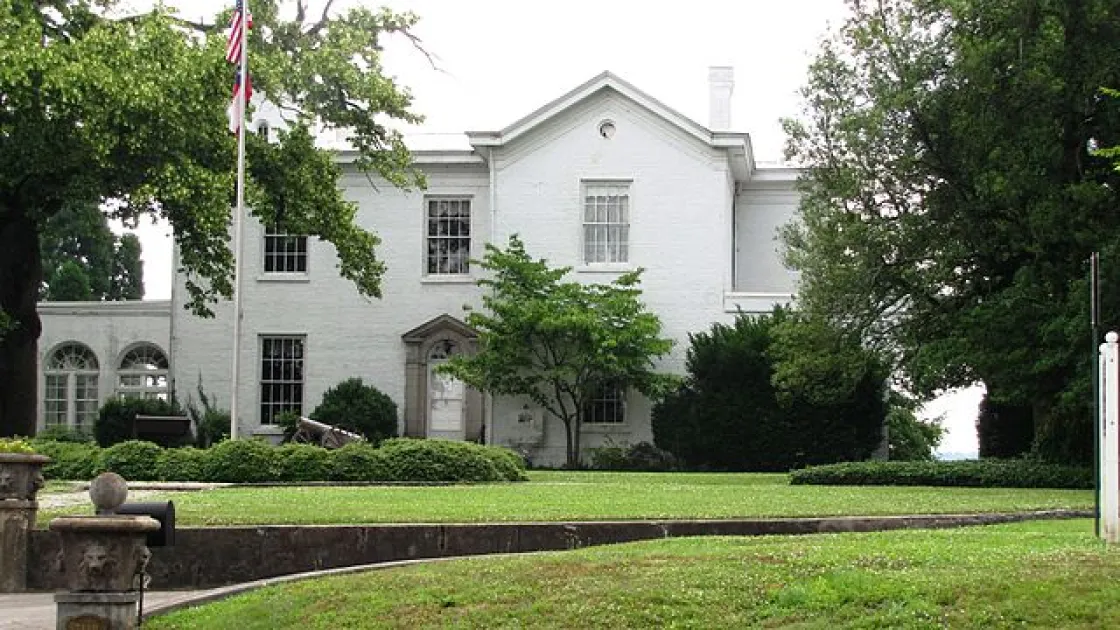
Poe used great inventiveness to make the badly sited Fort Sanders impregnable. The design featured an unusually deep ditch and steep parapet wall, stretching 20 feet from the base to the top at many locations. Foul weather made the walls icy — a circumstance some sources say was augmented by cistern water poured over the sides — and the lack of a berme made assault yet more difficult. In front of the fort, wire entanglements were looped from stump to stump, creating a nearly invisible impediment, while furrowing in the red dirt funneled an advancing enemy into areas covered by the Federal guns.
Artillerist extraordinaire Lt. Samuel Benjamin prepared paper fuses for Hotchkiss shells that were lit by hand and thrown over the wall. His tripled-shotted cannon were also devastating. “By the 20th of November, our line was in such condition as to inspire the entire command with confidence in our entire ability to hold the place against any rebel force that might be brought against it. But our men still continued to strengthen the lines by every possible means with in their reach,” Burnside reported.
William P. Sanders, a true hero
Almost as soon as he made it back from Loudon with his exhausted troops, Burnside approached the newly appointed Brig. Gen. Sanders and asked whether the latter’s mounted troops could delay Longstreet’s advance long enough for Poe to complete construction of the earthworks. Sanders committed to holding the line until noon of the next day. Accounts of his leadership have him sitting on a white horse riding up and down in front of the Union line unprotected from withering rifle fire.
Sanders and his 700 men bought vital time with their heroic stand, but the commander paid with his life; he was hit by a sharpshooter on November 18, 1863, and died the next day. “The hours in which to work that the gallant conduct of our cavalry secured for us were worth to us a thousand men each,” later recalled Poe “Every spadeful of earth turned while Sanders was fighting aided in making our position secure and he had determined to sacrifice himself if necessary for the safety of the rest of the army….The fort in front of which he fell was immediately named after him in commemoration of the service rendered.”
Battle of Fort Sanders
At dawn on the morning of November 29, 1863, 4,000 battle-hardened Confederate veterans launched a direct assault against the northwest bastion of Fort Sanders. Inside the fort, the 200 seasoned defenders in that sector were quickly doubled. Longstreet hoped to throw enough bodies at the parapets to overcome the fort’s firepower and engage in hand-to-hand combat inside the breached defenses. With the fall of Fort Sanders, he reasoned, would come the capitulation of the rest of the command. But Poe’s all-encompassing preparations prevailed. “That Longstreet’s renowned infantry failed to carry it by assault demonstrated that there were no very serious defects unprovided for,” he wrote after the war.
In 20 horrible minutes, the Confederacy suffered 813 casualties; the Union only 13. In the meantime, Longstreet received word that Grant had been victorious in Chattanooga, meaning a second assault would serve no purpose. A truce was called for the rest of day to deal with the dead, wounded and prisoners, after which the siege recommenced. But the Knoxville Campaign was essentially over.
Private correspondence shows Poe’s own recognition of his accomplishment. “Fort Sanders had a bloody baptism. I am, as the engineer officer who constructed all these works, the lion of the hour.” “For my own part I have felt much encouraged since the assault of Sunday morning, for our success was so signal, that it led me to hope everything. What a brilliant page it will make in the story of this war.” “And my ‘ditch digging’ saved Knoxville—my praises are in every man’s mouth, and If I do say it myself, I have done my whole duty, mentally & physically and have established my reputation as an engineer, upon no mean basis,” he wrote to his wife.
On December 6, an exhausted and angry Sherman, having raced to the aid of comrades believed to be in desperate conditions, arrived in Knoxville to find Longstreet gone and Burnside feasting. He did, however, know excellent work when he saw it. “We examined his lines of fortifications, which were a wonderful production for the short time allowed in their selection of ground and construction of work. It seemed to me they were nearly impregnable.” Sherman seemingly resolved to take further advantage of that talent.
Orlando Poe’s Legacy
As the military emphasis shifted south, east Tennessee was abandoned to lawlessness and civilian misery. Poe became a weapon in Sherman’s arsenal. In the unfolding drama, it did not matter whether Longstreet won or lost at Knoxville. Engineering saved the town, saved hundreds of lives, and was a testimony to military science, but the achievements of the Union army and its brilliant engineer in that brief, complex and intense episode were eclipsed by subsequent grander developments — lost to time and relegated to obscurity.
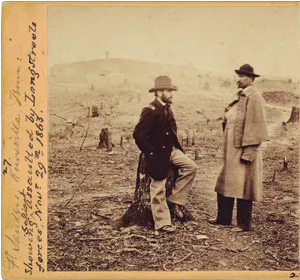
As a result of his fine work in Knoxville, Poe was handpicked to accompany Sherman on the Atlanta campaign, during which the engineer was responsible for the acclaimed (or infamous) railroad destruction and reconstruction, pontoon bridges, corduroy roads, and all elements of the unprecedented movement of 60,000 troops across Georgia. Sherman wrote, “I am well pleased with Captain Poe, and would not object to half a dozen thoroughly educated young engineer officers."
After the war, Poe served on Army commander Sherman’s staff from 1873–1883. It was not until 1889 that Poe, in a private railroad car, retuned to Knoxville. Interviewed by a local reporter, he declared that Longstreet had attacked at exactly the weakest point in the Union defenses and if a successful assault had been possible, it would have happened there. By the 1890s, Poe’s career was focused on the Great Lakes, and his lasting legacy has proved to be the fine system of lighthouses constructed with his design. When he died in 1895, the ships of the Great Lakes flew their flags at half-mast for two weeks.
Knoxville, the Forgotten Front
Politically, President Lincoln cared about the civilian population of “Loyal Mountaineers” from the outset of hostilities; first general–in-chief George McClellan also valued Knoxville as a military objective in the early months of the war. However, later military strategists in the West saw no advantage in occupation when compared to the cost of getting an army into east Tennessee and maintaining it there. It was all about geography; neither communication nor supply lines could be reliably created or maintained. The mountains were too high, the rivers too shallow, the plateau too difficult to scale, the neighbors too hostile, the railroad too easy to disable, the telegraph too easy to cut. Without a railroad connection through Kentucky to Ohio, a Federal army large enough to thoroughly control the region could not be sustained.
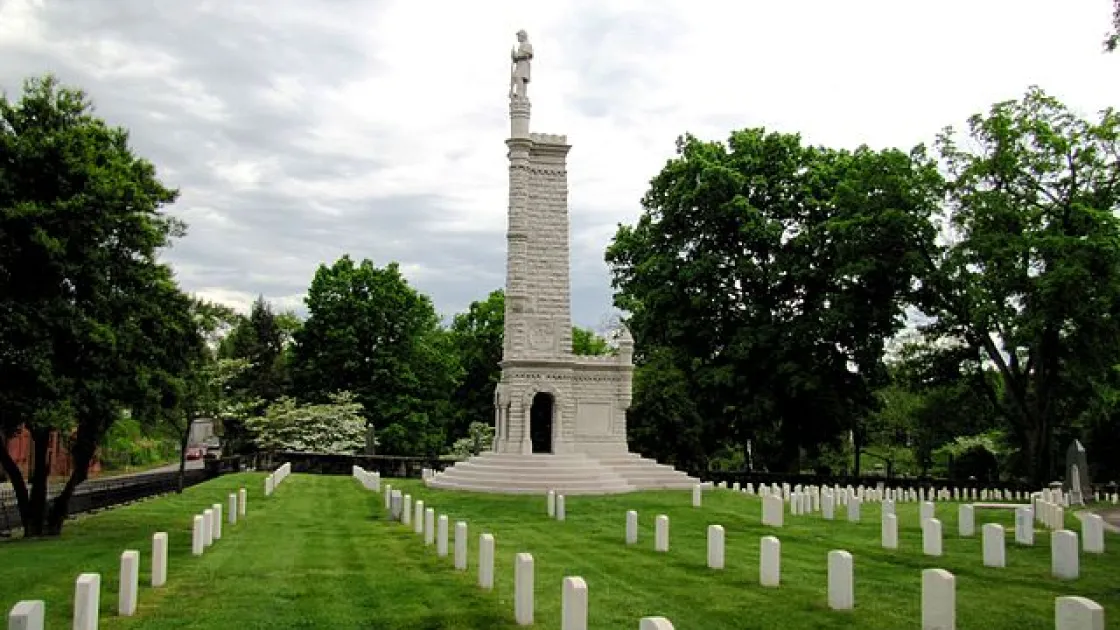
East Tennessee itself lacks cultural recognition of this traumatic time. After the war, regional attitudes dictated leaving the past alone. It was much too divisive to memorialize and commemorate. The very fact that all elements of a civil war played out on Knoxville’s stage —a divided civilian population, fighting-age men enlisted for armies on both sides, social institutions tested to the limit, human nature versus social control — made it too dangerous a memory.
After the surrender, the citizens felt they could not live peaceably together if the past continued to play an active role. Thus, no true battlefield park was ever established or downtown monuments erected. No avenues or buildings were named for wartime heroes. While a wealth of family and personal stories still exists, the larger cultural identification with that part of the past is gone.
Help the Trust save 161 acres across consequential Western Theater battles — Fort Heiman and Fort Henry, Brown’s Ferry/Chattanooga, Spring Hill, and...
Related Battles
5,824
8,000


